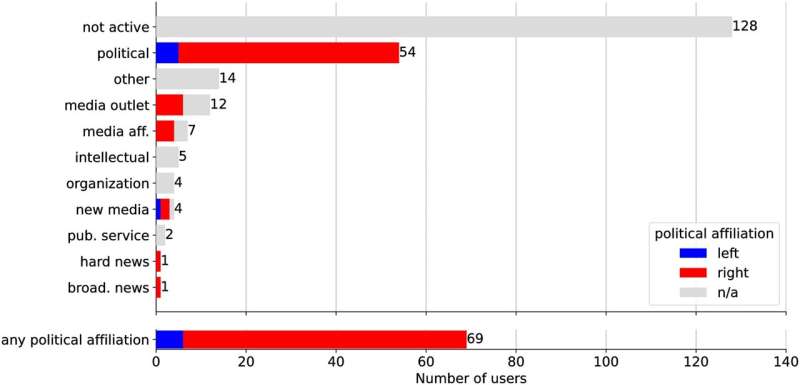Classification of superspreader accounts. A large portion (55.1%) of accounts are no longer active. For each class annotated with political affiliations, colors indicate the ideological split. The last group aggregates all accounts with political affiliations. Credit: PLOS ONE (2024). DOI: 10.1371/journal.pone.0302201
A small team of social media analysts at Indiana University has found that a major portion of tweets spreading disinformation are sent by a surprisingly small percentage of a given userbase.
In their study, published in PLOS ONE, the group conducted a review of 2,397,388 tweets posted on Twitter (now X) that were flagged as having low credibility and who was sending them.
Over the past several years, media researchers have found that social media sites such as Facebook, Twitter and Instagram can have a major impact on personal beliefs and social issues, including those of a political nature. Prior research has also shown that because of such influence, foreign entities have been posting entries on social media sites with the intention of swaying public opinion on a variety of issues.
In this new study, the research team found that it does not take a lot of influencers to sway the beliefs and/or opinions of large numbers of people. This, they suggest, is due to the impact of what they describe as superspreaders.
Like the superspreaders that were labeled as such during the pandemic, superspreaders on the internet have the ability to "infect" large numbers of people due to their reputation.
To learn more about influence on social media, the research team focused their efforts on Twitter. They collected 10 months of data, which added up to 2,397,388 tweets sent by 448,103 users, and then parsed it, looking for tweets that were flagged as containing low-credibility information.
They found that approximately a third of the low-credibility tweets had been posted by people using just 10 accounts, and that just 1,000 accounts were responsible for posting approximately 70% of such tweets.
They note that the majority of the superspreader accounts could not be traced to an individual, though there were a number of high-profile posters, such as politicians or generalist influencers, such as Donald Trump Jr.
The researchers note that many of the superspreader accounts they identified were disabled during a push by Twitter in 2020 to reduce the amount of disinformation on the site. But that trend is now in reverse as the site, now rebranded as X, has taken a new direction following its takeover by Elon Musk.
More information: Matthew R. DeVerna et al, Identifying and characterizing superspreaders of low-credibility content on Twitter, PLOS ONE (2024). DOI: 10.1371/journal.pone.0302201
Journal information: PLoS ONE
© 2024 Science X Network
























